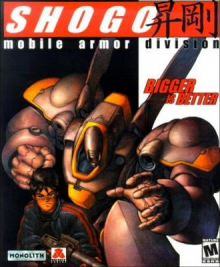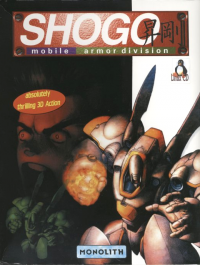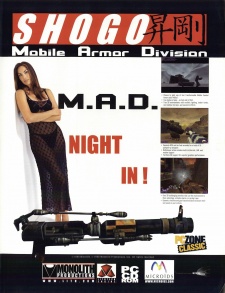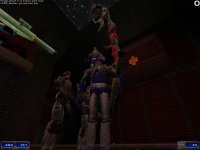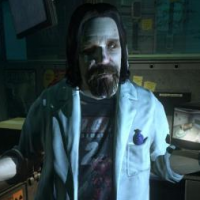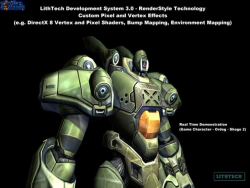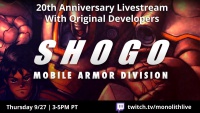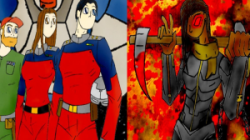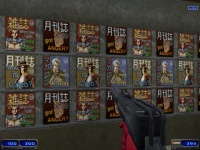Shogo: MAD
Developer: Monolith Productions
Publisher: Monolith Productions (NA), Microïds (EU), Titan Computer (Ports), Interplay (re-distributor)
Designer: Craig Hubbard
Engine: LithTech (1.0)
Version: 2.2.14 (Windows)
Released: September 30, 1998
Genre: First Person Shooter
Modes: Single-player, Multiplayer
Platforms: Windows, Apple Macintosh, GNU/Linux, Amiga
UPC/A7: N/A
ISBN-10: N/A
Media: CD-ROM(1)
This article is part of the Shogo Sub-Section and is not to be confused with the Blood Wiki proper.
"Shogo casts you in the role of Sanjuro Makabe, a Mobile Combat Armor pilot, Commander in the UCA Security Force. Control ultra-powerful mecha that, run, jump, duck, strafe, swim and stomp on enemy personnel. Wield gigantic, super-destructive weapons, and transform into a hovertank in 800 milliseconds flat. You may have driven giant robots, but you've never piloted Mobile Combat Armor. Until now." — Monolith website
Shogo: Mobile Armour Division (development titled as Riot, Heavy Metal and Metal Tek) is a first person shooter computer game released by Monolith Productions on September 30, 1998. It was the first game to utilize the LithTech engine, an engine written from scratch by Monolith.
It has heavy influences from Japanese anime, particularly Patlabor, Appleseed, the various Gundam series and other real robot mecha properties. However, it also follows many standard first person shooter conventions, allowing it to appeal to more than just fans of anime and mecha. The game allows you to pilot several large mobile combat armours, as well as perform missions on-foot.
Shogo was ported to the Amiga PowerPC platform in 2001 by Hyperion Entertainment. Hyperion also made the Apple Macintosh and the GNU/Linux port of Shogo. A version for BeOS was also once in production back in 1999 by Be Inc. and Wildcard Design.
Technical Specs[edit]
Windows Specs[edit]
| Minimum CPU Required: | Pentium |
| Minimum OS Required: | Windows 95 |
| Minimum RAM Required: | 32 MB |
| Minimum CD-ROM Drive Speed Required: | 4X |
| Minimum DirectX Version Required: | DirectX 6 |
| Input Devices Supported: | Keyboard, Mouse, other DirectInput device |
| Multiplayer Options: | Internet (TCP/IP) |
Linux Specs[edit]
| Minimum CPU Required: | 166 MHz x86 Processor |
| Minimum OS Required: | 2.2.x or better Linux kernel with glibc-2.x and X-Windows |
| Minimum RAM Required: | 32 MB |
| Minimum Disc Space Required: | 65 MB |
| Minimum Video Card Required: | Graphics card with 4 MB video memory |
| Sound Cards Supported: | OSS Compatible |
| Multiplayer Options: | Internet (TCP/IP) |
Gameplay[edit]
Shogo features a mix of both standard on-foot first person shooter action, and combat with anime-style bipedal mechs. Unlike mech simulator games such as the Mech Warrior or Heavy Gear series (where mechs are piloted in a manner similar to tanks), the mechs in Shogo are controlled essentially the same as a human first person shooter character would be. The mech missions are of average difficulty, and feature a variety of energy-based or explosive projectile weapons. Much of the action takes place within city areas.
The on-foot missions feature a variety of mostly hitscan firearms, such as dual Colt M1911A1 pistols, a MAC-10 Sub-Machine Gun, and an assault rifle (non-hitscan weapons include two types of grenade launchers and a BGM-71 TOW rocket launcher). These sections of the game are quite difficult; the player character (Sanjuro) cannot survive much damage, enemies are equipped with rapid-fire hit-scan weapons and have great aim, health items are somewhat scarce, and armour is extremely rare.
Shogo also has an interesting game play feature in its critical hits system, whereby attacking an enemy will occasionally bring about a health bonus for the player while the enemy in question looses more health than usual from the weapon used. However, enemy characters are also capable of scoring critical hits on the player. It should also be noted that each of the weapons in the game have different likelihoods of scoring critical hits on an enemy.
Story[edit]
"You play Sanjuro Makabe, a Mobile Combat Amror (MCA) pilot and Commander in the UCA Security Force. Your mission is to locate and assassinate a rebel leader known only as Gabriel. All of the action takes place either on the planet Cronus or on the spaceship Leviathan. The Leviathan is the flagship of the UCA and is commanded by Admiral Akkaraju. Cronus is the only known source of the biologically active material known as Kato, an incredibly powerful energy source essential to the process by which interstellar travel is possible." — Shogo manual
Shogo Levels
- 01 - The Ambush
- 02 - Calm Before the Storm
- 03 - Mission Briefing
- 04 - The Storm
- 05 - Approach
- 06 - City of Ghosts
- 07- High and Low
- 08 - Infiltration
- 09 - A Familiar Voice
- 10 - Escape
- 11 - Once a Thief
- 12 - Public Nuisance
- 13 - MEV Depot 17
- 14 - Maritropa Slums
- 15 - Lost Cat
- 16 - The Mecca
- 17 - Shinara District
- 18 - City on Fire
- 19 - Downtown Train
- 20 - Rescue Attempt
- 21 - The Favor
- 22 - Runaway Train
- 23 - Bullet in the Head
- 24 - An Old Friend
- 25 - A New Insight
- 26 - Oshii Research Station
- 27 - City of Hope
- 28 - History of Warfare
Option One
- 29A - Prodigal Son
- 30A - Belly of the Beast
- 31A - Central Command
- 32A - Countdown
Option Two
- 29B - City of Hope
- 30B - Unexpected Complications
- 31B - Hidden Fortress
- 32B - Brother's Keeper
- 33 - Epilogue
Players took the role of Sanjuro, a commander in the United Corporate Authority (UCA) Security Forces, during a brutal war for the planet Cronus (technically 46CronusD) and its precious ore (called kato). No specific time period is explicitly stated, although it is hinted to take place sometime in the presumably far future, and calendars inside the game hint that the events in the game take place in the month of July. Prior to the game's first level, Sanjuro had lost his brother (Toshiro), his best friend (Baku) and his girlfriend (Kura) during the war and now, it is revenge that drives him. That, and his dead girlfriend's sister (Kathryn), whom he is dating. In Sanjuro's words, "It's kinda complicated." The game's narrative is primarily what drove gamers to finish the game, as it featured a healthy dose of comic relief without becoming silly.
At two pivotal points in the game, the player also has the opportunity to make a crucial decision, which can alter the game's ending. While the first decision is almost purely a narrative decision, the second decision actually determines who you'll be facing the rest of the game and how the game will end. If nothing else, the ability to play the game twice with two different sets of final missions truly added to the title's replay value.
The game begins with Sanjuro being extracted from a reconnaissance mission two years after the mission against Ivan Isarevich that resulted in Kura, Toshiro, and Baku's supposed deaths. He is brought to the Leviathan, a UCA command ship, and receives his mission from Admiral Akkaraju, who is Kura and Kathryn's father. Sanjuro then is dropped onto the planet, briefly accompanied by his squad, to enter the city of Avernus and kill Gabriel, leader of the Fallen. Once Sanjuro reaches Avernus, a mysterious man called Hank Johnson, a "friend of a friend," warns him about reinforcements coming in. Sanjuro attempts to reach Gabriel's headquarters. But it's a trap: communications with the Leviathan are jammed by an interference array, and Uziel, Gabriel's right-hand man, blocks Sanjuro's way after claiming that he knows him. Sanjuro, assisted by Hank, reaches the base with the interference array, and assists a UCA unit, Strike Force Carnivore against the enemy. He deactivates the array and establishes contact, but hears Kura instead of Kathryn. It is revealed that Kura was not dead, and she asks to meet with Sanjuro in Maritropa, a nearby city on Cronus to explain everything. Admiral Akkaraju, however, dodges the question of why he didn't tell Sanjuro about this, and orders Sanjuro to withdraw. Sanjuro then exits through the sewer to avoid the reinforcements; in the process of doing so, he learns that the soldiers have overwhelmed Strike Force Carnivore, and have secured his MCA. Reaching a parking garage he passed through earlier, Sanjuro kills some soldiers and destroys a tank, allowing Hank to help him escape in the back of his truck.
Hank takes Sanjuro to a pumping station, and with his help, dispatches the guards and helps Sanjuro get another MCA. Despite Kathryn's insistence that Toshiro and Baku are dead, Sanjuro suspects that both are alive, and decides to meet Kura at a nightclub called "The Mecca." With two friends of Hank's, he proceeds through the city and reaches a train station after bypassing a security barrier, but is too late to catch the train. Sanjuro then passes through the slums of Maritropa, but an electric gate bars his way, and only a woman whose cat is missing is able to deactivate it. The player can either kill the woman and her husband and open the gate, or do an optional level which depicts Sanjuro's attempts to rescue the cat from some starving "stragglers" who have been severely affected by working with kato, leading to a humorous exchange between Sanjuro and Kura. Sanjuro also receives a health powerup as well as the cat's "toy" - a doll of Captain Nathaniel Joseph Claw from the earlier Monolith platformer Claw, that, when squeezed, says "Magic Claw" (Sanjuro actually gets to keep this item for the rest of the game). Sanjuro reaches the Mecca too late; Kura has been captured by the CMC, Cronus's relatively weak yet troublesome military authority, but not before she says that Toshiro is Gabriel, and vaguely mentions "Cothineal." Sanjuro reaches the club, and a businessman from Shogo named Ryo Ishikawa agrees to help Sanjuro save Kura in exchange for a favour. Sanjuro reluctantly agrees, and makes his way to the station, before moving crosstown in his MCA and taking out security barrier generators, before catching another train to the detention center. At the station, Hank tells him that Cothineal "is the reason the Fallen exist," but says that Kura can elaborate.
At the detention center, Ryo asks Sanjuro to deactivate a firewall. The player has another choice here; if he helps Ryo, Ryo will leave him stranded by deactivating an energy walkway, forcing Hank to help him escape. If he does not, Ryo triggers the alarms. In either situation, Sanjuro is forced to shoot his way through the CMC, rescuing Kura, who reveals that she was working undercover, which is why she was listed as dead. Kathryn then informs Sanjuro that the Admiral wants to fire the Levithan's kato cannon at Avernus despite High Command's insistence, but doesn't know why. Sanjuro, who knows that the blast could affect Maritropa and Constantine, asks Kathryn to delay the admiral until he returns. After defeating the Fallen assassins who are trying to kill Kura, Kura tells Sanjuro that Cothineal is the source of kato, and that Toshiro is acting as a pawn. Baku, meanwhile, has become insane, and as Kura notes, "I don't know what he's become, but he's dangerous." Kura expresses her concern that Admiral Akkaraju considers Toshiro a traitor. Kura then asks Sanjuro to come to the Oshii Research Station in Avernus, which supposedly has proof of Cothineal's existence and role. She then asks Sanjuro about his relationship with Kathryn, but the choice the player makes doesn't have any clear effect other than dialogue.
On the train ride back, an upset Kathryn shares her displeasure with Sanjuro. Ryo Ishikawa then contacts him, and reveals some of his more sinister dealings. He states that he played at least some role in Ivan Isarevich's rise to power, and implies that he has a stake in the current crisis in the excellent quote of "Two years ago, when you and your squad went into Avernus and killed Ivan Isarevich, you did a lot more than liquidate an up and coming tyrant- you wrecked a scheme that I'd nurtured for years. It's taken me a long time to recover from the mess you've made, and now you're trying to ruin me again. Who do you think tipped off the CMC about your little lovebird, anyway?" Ryo then sends the train out of control, and has the Shogo troops on board attack Sanjuro. Sanjuro saves the train, but when he gets back to the pumping station, it is overrun by Shogo troops. He is forced to watch as Ryo shoots Hank in the head with a shotgun blast, execution-style, killing him. Ryo escapes before Sanjuro can reach him. Kathryn expresses condolences, and convinces Sanjuro to go to the airship dock to reach the Oshii Research Station. He finds Uziel's MCA there, and forces him to retreat after a brief skirmish. He then contacts Toshiro, and arranges a meeting in the History of Warfare museum in Avernus. Sanjuro's efforts are nearly stymied when Admiral Akkaraju announces that the Kato cannon is charging and will fire in two hours; he cites evidence by Ryo Ishikawa, whom he sees as an ally, as proof of Toshiro's treachery. He also will not hear anything of Sanjuro's claims that if he fires the kato cannon and disobeys High Command, "The UCA will be thrown into chaos and the Fallen will be out of the way. The CMC is already in tatters- Shogo will inherit Cronus."
Sanjuro reaches the Oshii research station, and he and Kura find the necessary information despite a raid by Shogo troops. The Admiral reluctantly agrees, and gives Sanjuro one last chance to save Toshiro. Sanjuro reaches the History of Warfare museum, and sees Gabriel, who gives the player a choice of joining him or facing his armies.
Option One[edit]
Sanjuro accepts, and fights UCA troopers before reaching a ship to board the Leviathan. Sanjuro meets up with Kathryn, and fights his way through the ship to reach the kato cannon firing controls. With minutes left to go, Sanjuro disables them, and defeats Ryo, who plans on reactivating the kato cannon, which was most likely his reason for telling the admiral what he did.
The epilogue suggests that the Admiral will be court-martialed, the CMC has surrendered, and the Fallen have declared a truce with the UCA and Toshiro remaining on Cronus as an "ambassador" to Cothineal.
Option Two[edit]
Sanjuro refuses, and fights Fallen troopers inside the ruined museum. He escapes and, defeating Fallen troops in the city, proceeds on to the Fallen headquarters through the Madison Tunnel as he planned on using earlier in the game. He navigates through the city rooftops, and on to the outskirts of the city, where he learns that Shogo fighters are attacking the Leviathan. Sanjuro enters the elevator leading to Gabriel, and, brushing off Kathryn's concerns, fights with and defeats Baku. Sanjuro reaches Gabriel, who is being protected by an energy field that Cothineal creates, and learns that Shogo reinforcements will attack from behind. Sanjuro shoots Cothineal's eye, lowering Gabriel's defences, and disables Gabriel's MCA. He then defeats Ryo's reinforcements, and Ryo himself.
The epilogue notes that Toshiro is being treated for his time under Cothineal's control, and that Admiral Akkaraju will be investigated for disobeying High Command, but little will come of it. Humanity will also work to gain peace with Cothineal.
Expansion Packs[edit]
The expansion pack Shugotenshi would have given us more insight into Kura's roles. It would have been six or eight levels of Kura fighting the threat of a new militia of anti-Kato terrorists, dealing with Sanjuro and Kathryn and coming to terms with the death of Hank. Some features of that game would have been various body armour for Kura and new enemies and weapons for her to fight and use. Its name is a translation of the Japanese term for "guardian angel" which was a major theme in its storyline. Some deathmatch maps from the project were released as the Shogo Six Pack, as well as a previous technology demo using the popular "Maniac Challenge" custom levels.
Legacy of the Fallen would have moved away from the fighting of Cronus and taken the player to a remote Kato mining facility at Iota-33. It would show just how well organized the Fallen actually was and the weapon capabilities of an AMBED ("Advanced Mechanical Biological Engineering Division") team. Legacy of the Fallen was to have an entirely new cast of characters, five new mecha to choose from, six new on-foot weapons, five new mecha weapons, several new enemy aliens, and levels that played out more like Half-Life in level structure. It was cancelled after numerous delays. There was a postmortem on the game's creators (Anarchy Arts) website that placed the blame on poor distribution agreements, mismanagement of development resources, and development team burnout. Some of the resource files for the project have been released and there was a similarly ill-fated fan attempt to finish it (only a technology demo and a weapons mod were released).
"The first mistake we did, with LOF was to make it too big, for the ability of our crew. being an ADD-ON pack, and our first project we should have kept it simple, but the wish to release a kick ass ADD-ON product, and to do something new and unique was to strong, So We then Ended-up with multiple ending, almost 20 different way to go from level 00 to level 18, and a very complicated storyline. Very Soon we realized that we had put to much stuff into the game, and that it would be hard to do it all. Wanting to be true to our contract we tried to do everything, but near the end we found ourselves cutting stuff out." — LOF development postmortem
Public Reception[edit]
Because the game was released around the same time as Half-Life, it never performed well in the market. Half-Life came out only a few weeks after Shogo with much fanfare and a marketing campaign that allowed it to overshadow the other shooters that came out at the time such as SiN, Blood II: The Chosen and Shogo. Half-Life was packaged with video cards, joysticks and sound cards which allowed it to reach a much bigger audience than Shogo.
The marketing campaign for Shogo was simply not strong enough to overcome the distraction of Half-Life, even among those gamers who would have most appreciated its features and game play. However, Shogo has spawned a dedicated cult following that is still active today. It should be noted that Shogo took the first person shooter genre to new directions, especially with its unique narrative form and style. Shogo was well received for its complex cinematic-like storyline and, like the Blood series, for its creativity. It was also praised for having enough anime styles to interest fans but enough traditional first person shooter styles to interest other gamers.
However, its attempts to imitate anime artwork pre-cel shading received a mixed aesthetic reception, and some mecha enthusiasts criticized its fast action controls and lack of a sense of scale. Others complained of the game's simplistic and clunky artificial intelligence and unpolished feel in some areas. However, many fans felt that if Monolith had put more work into advertising then Shogo would have sold better, even with the distraction of Half-Life, and that the game being self-published following Monolith's split with Microsoft hindered its wider exposure.
The multiplayer elements of Shogo also received some criticism, particularly for online play, citing that it was slow, had trouble on certain modems, and lacked a lot of the features of other shooters out at the time. There was also the problem of people cheating during Internet play, which caused a certain amount of paranoia among the Shogo community over who were "cheaters"; later fan-made anti-cheat packages were created. The Red Riot weapon was also considered over-powered, and unfair for use in deathmatch.
The Shogo community, in part to combat some of these problems, created a number of multiplayer traditions, culminating in the Squishie modification. Another of these was "player"/"mech stacking", in which players would jump on top of each other into as high a pile as possible. Another was "mech surfing" in which one mech would transform into hover-transport mode and another would jump on top of it and try and ride it. There was even a Shogo player who played weekly Shogo hide and seek and tag games with his five year old daughter. Also, as with many games of the era, bullet art consisting of bullet holes in walls was popular, leading to the creation of the Shogo Paint modification.
The game finally returned back to the public spotlight, along with many others, when it was released onto GOG.com in 2009 by Interplay, who picked up distribution rights on June 1, 1999 after Monolith closed down its publishing wing with the departure of producer Matt Saettler. The game has also since been released on the Steam platform, becoming available on April 11, 2017. Recent reviews have often focused on the debated effectiveness of the critical hits system, as well as how successful the game truly is at capturing the feel of genuine anime or demonstrating a sense of scale during the MCA missions.
"GOG.com and Steam both have it available. GOG is ~ $6 with soundtrack included. We don't get any revenue from this - we're just happy you'd want to play." — Monolith Productions on Facebook
Shogo was also released with dubs in other languages, including French (example), Spanish (example), Polish (example), and Russian (example). All of which, as well as being released on the Amiga computer more popular in Europe, has allowed the game to grow a European following. Shogo was also listed as a launch title for the Indrema, an early attempt at a Linux-based video game console pre-dating the Pandora and Steam Machine/Steam Deck.
Legacy[edit]
See Also: Future of Blood
"Shogo 2 takes place quite some time in the future beyond Shogo; as long as you stick to the timeline and don't radically change the universe, you don't need to worry about conflicting storylines. Ideally, this document - complete with fan community additions - will be used as the backstory/continuity guide for Shogo 2. Storyline for Shogo 2 will be revealed at a later date, especially since the project is still completely in the design phases and won't begin to get coded for some time. :)" — "Loki" Blackman on continuity
Despite some previous intentions, Monolith Productions has repeatedly stated they have no current intention of doing a sequel, but numerous Shogo themed easter eggs have turned up in their later projects. No One Lives Forever featured Hank Johnson's grave in the game's last level; The Matrix Online features a nightclub called "Club Shogo"; Tron 2.0 features a Shogo arcade machine; Blood II: The Chosen features Shogo posters in various rooms in the CabalCo building's living quarters as well as on subway platforms, reflecting the fact that the games were developed alongside each other.
The most pronounced expression of this is in F.E.A.R., which has the Armacham company name, the Bullgut (called the "MOD-3 Multi-Rocket Launcher") and even the Shredder (called the "MP-50 Repeating Cannon") as weapons, plus a secret room with a radio that plays the opening theme music from Shogo and uses a Shogo texture depicting a man riding on a horse. Plus there are also textures that depict the Enforcer mecha as belonging to Shogo Industries and a texture depicting the Shogo cover art, probably as a poster. Some players have even said that the UAV in F.E.A.R. looks similar to the Spider Mine in Shogo. F.E.A.R. 2: Project Origin has a man called Terry "Snake Fist" Halford wearing a "Shogo 2" t-shirt.
"The games make many, many references to Shogo: Mobile Armor Division, Monolith's first fully-3D first person shooter. In the first game in particular, Armacham Technology Corporation is named after one of the three companies that merged to create the UCA in Shogo, the VK-12 shotgun is attributed to the same manufacturer as Shogo's shotgun (and is incidentally based on the same real-world weapon), and two other weapons are also based on ones from Shogo, the MOD-3 rocket launcher working similarly to the Bullgut (also being attributed to Andra, the manufacturer of the "Predator" in Shogo) and the MP-50 repeating cannon based on the Juggernaut. A secret room in one of the final levels has a texture from Shogo (a whiteboard with a silly drawing on it next to a note saying "no drawings!") and a radio that plays a radio report from Shogo (one about a pile-up caused by an overly-bright and chromed vehicle blinding other motorists), then the Shogo theme song. Several more weapons in Project: Origin are also apparently manufactured by companies from Shogo (Andra particularly again, making the submachine gun and rocket launcher), and Snake Fist wears a Shogo 2 T-shirt. Also, newspapers found throughout the game make reference to the formation of the UCA, the One World Government from Shogo." — Kian Trip
"So did you think I was going to get through this review without mentioning the hugely satisfying mechs? Now roll back a number a years, some of you gamers may recall a certain mech based title crafted by the hands of Monolith which in my opinion was greatly underrated. That's right, Shogo: Mobile Armor Division, coincidentally it is also the first time we encounter the Armacham name. Could these two games be linked in the future? Or simply just using the name as it suited the F.E.A.R scenario? Who knows but I digress." — Neil 'Wedge' Hetherington, GameGrin
When a development image of this was released on December 22, 2008 it caused a lot of industry and fan speculation over whether or not this was just another reference, or if it hinted that Monolith was interested in making another Shogo game. A previous case of such speculation came in March 2001 after the release of a promotional demo for the ill-fated LithTech 3.0, which featured mechs and Shogo-like environments. Shogo community member Allan "Geist" Campbell happened to work for LithTech Inc at the time. Other rumours were that Monolith was considering a third person shooter sequel to Shogo for the Xbox console, allegedly set in a futuristic Tokyo.
"If Shogo 2 were underway, it could likely be an Xbox title, but the fact is that the images on the net that are creating that perception are just LithTech Inc. supplied images that are using some art assets to demonstrate RenderStyles. Those images happen to partially contain some Shogo 2 concept stuff. The shots do not come from Monolith, actually they are coming from LithTech Inc. I cannot confirm or deny a Shogo 2." — Jason Hall, March 22, 2001
Craig Hubbard has revealed that No One Lives Forever started out life as "a mission-based, anime-inspired, paramilitary action thriller intended as a spiritual sequel to Shogo", a design that was later reconstituted into F.E.A.R.. Jason Hall listed several anime influences on Tex Atomic's Big Bot Battles, as well as their own earlier Shogo.
Jason Hall has stated that the intellectual property for Shogo is still owned by Monolith Productions/Warner Bros. Interactive Entertainment, despite Interplay still exercising distribution rights via GOG.
"Also intentional. Everyone at Monolith is still big dorks about Shogo and they love it to death (I worked there for 6 years, so I know this). They actually would love to do a Shogo 2, but they don't have confidence in it's sales because the first one was a cult hit, but didn't sell well. Other than few people on message boards going "SHOGO!!! YEAH!" from time to time, there's no interest, so they don't seriously talk about it. But anyways, they had the little Powered Armors in the first game, so they thought this was a good opportunity to get a big mech battle in the game. Was always one of my favorite parts, actually." — Dusty, January 23, 2009
"I would do it in a heartbeat if somebody was willing to fund it, but I don’t know that the game I’d want to make would be the one that fans would expect. About ten years ago I actually came up with an idea for a reimagining that I was really excited about, but there was zero interest in either the franchise or the subject matter from the people who would have needed to be on board in order for it to get greenlit. Maybe someday…" — Craig Hubbard, October 4, 2016
"I always felt SHOGO ended up as more of a promising prototype than a full-featured product, so there's probably not a lot I would keep the same if I had it to do all over again. The biggest change, as I mentioned above, would be to rethink the scale of the MCAs, ideally so that we could have let players transition in and out of them at any time. I'd also aim for a more relatable setting, since I think the power fantasy of being in a giant robot works best when the environment you're crashing through feels familiar. And I think we should've gone with a story premise that required less exposition, but I was reluctant to throw away the work that had already been done before I joined the team. I'm a lot more pragmatic nowadays." — Craig Hubbard, October 4, 2016
Influence[edit]
See Also: Blood in Other Media
With 'old' I was expecting like at least a 90s game like Shogo or Slave Zero. Shit we are old. — Cyberblood
Released a year later in 1999, Slave Zero featured similar mecha mechanics and aesthetics to Shogo; it was third-person focused with an optional first-person mode, the inverse of Shogo. The 2001 Zone of the Enders combined mecha with third-person shooter combat, while Bungie's game Oni from the same year mixed anime with third-person combat on foot. The game Dark Horizons Lore: Invasion (2005-2006) also features more streamlined mecha combat similar to Shogo. The game Robotech: Battlecry (2002) developer Vicious Cycle Software even hired Shogo modder Allan "Geist" Campbell during its development, and followed it up with Robotech: Invasion (2004). The indie game Silver Knights (2002) also has a similar feeling.
Gundam was converted into a first-person game with a 1995 PlayStation title, then Gundam Gaiden III for Sega Saturn in 1997, and most recently adapted into an online free-to-play first-person shooter in 2022 as Gundam Evolution. Ghost in the Shell was adapted into a first-person shooter twice, with Ghost in the Shell: Stand Alone Complex in 2005, and Ghost in the Shell: Stand Alone Complex - First Assault Online in the mid-2010s. The 1988 game Japanese game Star Cruiser features segments remarkably similar to later first-person shooter games.
The indie game Hawken (2012-2018) was variously described as similar to Shogo, with a new variant called Hawken Reborn launched in 2023 to negative reception. The 2014 multiplayer title Titanfall also features mecha elements with hints of anime, with a Rock Paper Shotgun article remarking of the single player for Titanfall 2 (2016) that "this is the game that Shogo: Mobile Armor Division wanted to be all those years ago, and that Monolith took another swing at with F.E.A.R. 2’s mech sections". Mullet MadJack (2024) features fast paced first-person gameplay with a manga inspired art style, with a similar presentation in the speedrunning first-person shooter Neon White (2022).
The Evarena mod for Unreal Tournament 2004 also fuses first-person shooter combat with mecha anime (in this case Neon Genesis Evangelion, which was also attempted as a Half-Life 2 mod among several others, and even as a mod for Shogo itself), as does the Gundam Universe mod for Quake III Arena. A mod inspired by Sailor Moon was released for UT '04 in 2024. The Otakon, Transfomers and Robotech TC mods for Doom and Duke Nukem 3D mixed in anime and mecha as early as 1996 and 1997, with Shadow Warrior featuring light anime touches. The racing game Locus (1995) by neighbouring Seattle studio Zombie (alongside first-person shooter puzzler Ice & Fire), which was worked on by Mike Dussault, featured mecha driving similar to the hovermode for MCAs. Another neon cityscape hovercraft shooter, Jump Raven, was released in 1994 by CyberFlix. The Doom engine indie game Twilight Town: A Cyberpunk FPS (2023) features an Japanese-infused cyberpunk aesthetic, as does the Unreal Engine 4 title The Citadel (2020) and its upcoming sequel Beyond the Citadel.
More recently mods have been made for modern Doom ports based on Evangelion, Robotech, Gundam, and Attack on Titan, as well as the more general Highway Accelerated Booster, Netronian Chaos, Demonsteele, and Iron Bound. Generic mecha mods include Iron Assualt, Mechatron, MechDoomer, SECU DOOM, and NecroDoom. Zillion 3D derived from Wolfenstein 3D is also anime inspired, and the Armor of Acheron: Zero Armor project later evolved into the DarkPlaces based RetroBlazer (whose engine hosted the anime inspired XDBase project). There are also mods for Counter-Strike based on Patlabor and Appleseed.
As an adaptation of Japanese mecha anime into a Western mold and style, Shogo can be seen as a predecessor of Guillermo Del Toro's 2013 film Pacific Rim.
Several attempts by the community to create a sequel, direct or spiritual, have also been attempted.
Shogo 20th[edit]
In September 2018, to commemorate the game's 20th anniversary, the official Monolith Productions Facebook page started posting concept art and other bits and pieces from the game's development under the hashtag #Shogo20th. They also released the game's soundtrack onto SoundCloud.
"“It’s kinda complicated.” So begins Shogo - one of the first FPS to offer a branching narrative and different endings depending on player choice. Sibling rivalries, an unexpected love triangle, and shifting loyalties abound in the finest anime tradition. (Oh, yes!)... As much as we also love our back catalog, the truth is we're just not staffed to undertake remasters, backwards compatibility, or sequels while also working on our next big project. Shogo is beloved here at the studio and there are still many of the original devs from that era (if you can believe it!) - so we thought it would be fun to reminisce and open the art vault for the 20th anniversary. But that is all it is. No secret sequel is in the works, friends." — Monolith Productions, #Shogo 20th
This all built up to a two hour long live-stream with the original developers playing the game with commentary on September 27, 2018 from three to five post meridiem Pacific Time. During the stream, signed concept art was given away in the Weapon, Cronus, Heavy Metal, Akkaraju, Sanjuro and Character Prize Packs, as were shrink wrapped CD-ROMs circa 1998.
"We'll be livestreaming Shogo with some of the original Monolith developers - sharing behind-the-scenes stories and giving away lots of concept art and a couple of the original CDs - still in shrink wrap! See you here." — Monolith Productions, September 27, 2018.
Relation to the Blood Franchise[edit]
See also: Monolith multiverse
Shogo: Mobile Armour Division was released shortly before Blood II: The Chosen in 1998, and is in many ways its sister game. Shogo and Blood II do share objects with one another and since they both use the same version of LithTech they can use some of each others' levels and objects. Part of the original development plan for Blood II involved contributions from "Team Shogo" after the latter game shipped, but delays prevented this from happening significantly, leading to some of the lack of polish seen in Blood II and demonstrating the trouble with Monolith's attempt to develop two big name titles simultaneously.
In Blood II advertisements for Shogo can be seen on the walls at various places such as the numerous subway stations. Shogo also has a reference to Blood: on magazine stands there is a magazine with Caleb shown on the cover, accompanied by Japanese characters alongside English text reading "Who is Caleb?". Fallen troops can on occasion be heard exclaiming translatable cultist phrases.
Interestingly enough there is a character in Shogo called Gabriel, though it has no known relation to Gabriel from Blood. Shogo also reused the name "Nathaniel" from Claw for the name of the Admiral, as it did again for Nathaniel Cain in Sanity: Aiken's Artifact; the Claw character was also voiced by Stephan Weyte. Shogo was ported to GNU/Linux, Macintosh, and AmigaOS in 2001 by Hyperion Entertainment, which thereby allows for some Blood II content to be ran on these systems.
The Shogo community made fan art was inspired by the Blood fan art and was actually created by many of the same artists (notably Rust). The collection of Shogo fan fiction called The Expanded Canon was inspired by the Blood fan fiction and shared some of the same authors; Caleb on Cronus which is part of the Tome of Blood is part of the "Alternative Universe" collection of the Expanded Canon.
External Links[edit]
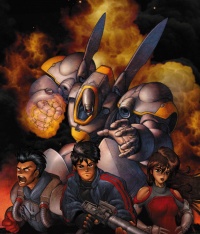
- Official homepage
- Monolith Productions homepage, newer page, older page (original developers and Windows version)
- Hyperion Entertainment page (AmigaOS, GNU/Linux and Macintosh version)
- Wildcard Design page (cancelled BeOS version)
- Titan Computer page (Linux publisher)
- Download Shogo Windows demo
- Download Shogo GNU/Linux demo
- Download Shogo Macintosh demo
- Download Shogo AmigaOS demo
- Purchase Shogo for Windows from GOG
- Purchase Shogo for Windows from Steam
Interesting Links[edit]
- Shogo: Mobile Armour Division on Wikipedia
- Shogo: Mobile Armour Division - MobyGames
- Shogo: Mobile Armour Division - Giant Bomb
- Shogo: Mobile Armour Division - GameFAQs
- Shogo: Mobile Armour Division - Kotaku
- Shogo: Mobile Armour Division - IMDB
- Shogo: Mobile Armour Division - Universal Videogame List
- Shogo: Mobile Armour Division - The PC Museum
- Shogo: Mobile Armour Division - MyAnimeList
- Shogo: Mobile Armour Division - PC Gaming Wiki
- Shogo - Linux Game Tome (original)
- Shogo - Linux Game Book (French and English)
- Shogo - HOLARSE, Spielen unter Linux! (German)
- Shogo: Mobile Armour Division - Macintosh Repository
- Shogo: Mobile Armour Division - Macintosh Garden
- Shogo: Mobile Armour Division - Macgamefiles.com
- Shogo - Lemon Amiga
- Shogo - Hall of Light: The Database of Amiga Games
- Shogo: Mobile Armour Division - Generation Amiga
- Shogo development screenshots (August 19, 1998)
- Shogo at FirstPersonShooters.net
- Shogo at 3D Gaming World
- The Unofficial LithTech FAQ (November 1, 1998)
- Game Unleashed - Shogo: Mobile Armor Division
- Revolt: Riot Information Center (ancestor to Planet Shogo)
- Shogo: MAD on TV Tropes
- Shogo - Doc's Office Unoffical Mac Ports
Reviews[edit]
Contemporary (1998-2001)
- Review by Gamespot (October 13, 1998)
- Review by IGN
- Review by GamePro
- Review - by Game Revolution (1998)
- Review - Inside Mac Games
- Shogo: Mobile Armor Division Preview - Blues News (October 1, 1998)
- Review of the Shogo demo - Quake Wiki
- Review - Planet Quake (1998)
- AllGame Review
- Review - Game Revolution
- Review Center (1998)
- GamePower (1998)
- 3DSoundSurge Review (1998)
- Cincinnati.com Review
- Shogo: Mobile Armor Division Review - ShootGen
- Review by Game-Over (September 29, 1998)
- Review by The Adrenaline Vault (October 8, 1998)
- Review by CDMag.com (October 9, 1998)
- Review from 3D Gaming (October 12, 1998)
- Review by sharky extreme (October 21, 1998)
- Review by Next Generation (October 26, 1998)
- Review by C/NET Game Center (October 27, 1998)
- Review from 3D Gaming World (October 28, 1998)
- Review by Wewp! Entertainment (October 31, 1998)
- Review by Games.Net (November 12, 1998)
- Review by The Review Center (1998)
- Review by Voodoo Extreme (November 16, 1998)
- Review by Games Domain (November 1998)
- Second review by Games Domain (December 1998)
- Shogo: Mobile Armour Division - Maximum PC (December 1998)
- Shogo: Mobile Armour Division - PC Accelerator (December 1998)
- Shogo: Mobile Armour Division - Next Generation #50
- Shogo: Mobile Armour Division - Computer Gaming World #174 (January 1999)
- Shogo: Mobile Armour Division - Game Informer #70 (February 1999)
- Review from 3DsoundSurge (1999)
- Review from Unnamed Gaming Review (1999)
- Review by GameGirlz (1999)
- Review from Loony Games (1999) (Pixel Obscura: Standing on the Shoulders of Metal Giants)
- Review by LANparty (1999)
- Linux specific review from Evil3D (2001)
- Linux specific review from Haus of Shogo (May 3, 2001)
- Amiga Games Database (2001)
- GamesMania Review for Macintosh (March 29, 2001)
- Gamers Mark Review (December 18, 2001)
- Review by Computer and Video Games (August 13, 2001)
- Review by AGN
- Review by GamePower
- Review from TechSpot (defunct)
- Article by TechSpot
- Review from GameFirst!
- Review by GameGenie
Retrospective (2002-Present)
- Shogo review (August 1, 2002)
- Review from Netjak (August 19, 2004)
- Review on Socksmakepeoplesexy.Net (2005)
- Review from Force for Good (March 2005)
- Review by Everything2 (January 4, 2006)
- User review - GameSpot (December 3, 2006)
- PC Feature - A Return to Shogo (July 14, 2007)
- Blast from the Past: Shogo: Mobile Armour Division - Tentative Name (March 19, 2009)
- Alternate History: Shogo: Mobile Armor Division (October 21, 2011)
- Review from Videogame Potpourri (April 13, 2012)
- from 1 More Castle (June 2012)
- Back Catalogue: Shogo: Mobile Armor Division - IVG (August 1, 2012)
- Reinstall: Shogo: Mobile Armor Division - PC Gamer (December 19, 2012)
- SHOGO: MOBILE ARMOR DIVISION - POST CONSOLE (March 11, 2013)
- Shogo: Lessons from the 90’s - INKapable (August 25, 2013)
- Lookback on Shogo - Eden for Gaming (March 12, 2014)
- Shogo: Mobile Armor Division - Less Than Mechcellent - The Escapist (March 15, 2014)
- Shogo: Mobile Armour Division PC Game Review - Virtual Urth (October 8, 2014)
- Review from DumeeGamer.com (October 23, 2015)
- Review from Mind of Askew (January 20, 2015)
- Tribute Thursday: Shogo: Mobile Armor Division - Kotaku (September 17, 2015)
- Review from LagSwitch (October 15, 2015) (defunct)
- SHOGO: The Most Fascinating Shooter You Never Played - TechRaptor (October 6, 2016)
- Jack Red reviews Interplay Build Your Own Bundle (November 20, 2016)
- Review: “Shogo: Mobile Armor Division” (Retro Computer Game) - PekoeBlaze (June 12, 2017)
- SHOGO: Mobile Armor Division - Monolith's forgotten mech shooter - Eurogamer (July 16, 2017)
- The Value of Stupidity with Shogo: Mobile Armor Division - Bi The Dark Side (September 4, 2020)
- Shogo: Mobile Armor Division - Jonathan Kaharl - Hardcore Gaming 101 (November 12, 2020)
Forum Threads[edit]
- Amiga.org thread
- Nostalgic forum thread
- Shogo: Mobile Armor Division
- Why was there never a Shogo sequel? - Rage3D Discussion Area
- There is a God! Shogo on GoG - AnandTech Forums
- Shogo ... who remembers this - Ars Technica OpenForum
- Why didn't SHOGO take off? - Ars Technica OpenForum
- Shogo - Stoudson Corporation
- Shogo:MAD needs a sequel - [H]ard|Forum
- Thread - RPG Codex
- Thread - Crunchyroll
- Does anyone else remember how awesome Shogo: Mobile Armor Division was? - Reddit
| |
|
Shogo: MAD, Development, Characters, On-Foot, MCA (Mech), Factions, Enemies, Elements, Quotations, Guides, Community, Mods, Fan Artwork, Videos |
